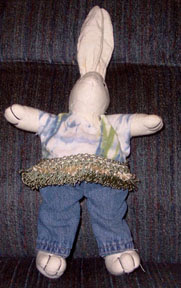
A few weeks ago, my friend Julia said that she wanted to know more about the Devil Dog Wine. Here you go, Julia- way more detail than you probably wanted. I remember from our college days that you liked wine, but not with food.
When we moved into this house in 1997, there was a 20 year old Concord grape vine in the side yard. Chuck decided he wanted to make wine. We knew nothing about making wine, other than it came from grapes and people crushed them with their feet. It took us a few years, but in 2002 we harvested grapes and gave it a try.
In 2002 and 2003, he tried making a dry wine because that's what I like. It was not successful. The 2004 batch had an accident and went bad. In 2006, he decided to make a sweet wine. He was looking for a taste like Wild Irish Rose, or MD 20-20. He decided to label it Devil Dog 50-50, and put a picture of our dog in a devil costume on the label. The slogan that year was "Odds are even you'll get bit." The sweet wine was successful. We took bottles home with us for Thanksgiving, and family members seemed to like it. In 2007 we made a sweet cherry wine, that was also very popular. He continues to use the Devil Dog label, and changes the slogan. This year he made a pseudo Limoncello, the slogan was "Bad as a Junkyard dog."
The process for making wine is this:
Pick grapes: This past fall we picked approximately 45 pounds of concord grapes.


Stem and sort: In the past we have left the stems in, but found gave the wine some bitterness we didn't like.
Crush
 : We have tried using hands to crush, a feet to crush (very bad idea) and a method using two 2 liter bottles. This year we ground the grapes with the meat grinder- it worked very well, and we'll continue to do this.
: We have tried using hands to crush, a feet to crush (very bad idea) and a method using two 2 liter bottles. This year we ground the grapes with the meat grinder- it worked very well, and we'll continue to do this.
Put juice into a 7 gallon plastic bucket. Check with a hydrometer for sugar content, called a Brix test. Certain yeasts provide certain amount of alcohol, and require certain levels of sugar to do so. We use a champagne yeast that yields a 19% alcohol, so Chuck adds sugar until the hydrometer shows 19, then adds a packet of yeast.
Cover the bucket, put in a warm dark place for several days. A crust made of dead yeast cells and grape skins and seeds will form on the top- It must be punched it down everyday- The house gets a vague yeasty smell.
After about a week, he checks again with the hydrometer, and keeps checking daily until it registers 0- at that point all of the sugar has been changed to alcohol. Usually the crust sinks to the bottom by this point. We let it sit with the skins in for another week because we like the dark color, but we don’t stir after it has reached 0.
Siphon the wine out of the bucket into a 5 gallon glass jar (carboy) leaving the dregs in the bucket.
Add 1 Campden tablet (potassium metabisulfite) per gallon to stop any yeast growth. An air trap on the top of the bottle lets the wine breathe but doesn’t let anything come in from outside. Chuck then lets it age and clarify a month or so.
Siphon over to another carboy, leaving any dregs in the first one. Add more sugar to taste, and 1 Campden tab per gallon to stop additional fermentation. (This is how we lost the 2004 batch- we added more sugar, didn't stop the fermentation and the bottles popped their corks. It was a mess.) Some people do this several times- over several months, Chuck doesn't bother. One month of fermentation is OK with him.
Bottle, cork and seal. I have short videos of these processes. I apologize for the sideways orientation- I didn't realize when I made them that I wouldn't be able to rotate the screen without distorting the sound.
Filling bottles. We got 3.5 gallons of wine from 45 pounds of grapes. This was the first year Chuck didn't add any additional water.
Corking bottles
Sealing Bottles
When offered a glass of wine, Boodles revealed that she is a tee-totaller.

A Google search on Making Wine will yield lots of results, if this has inflamed your imagination.






2 comments:
Interesting!!
My Dad just has the grapes crushed by relatives who have a fruit-press (to make apple/pear-cider or such) - we leave most of the wine & the grapes to them too, as not that much alcohol is consumed by us!
Interesting that you managed to make it good - with the same grapes or a different sort? (we have not-so-good grapes, so we thought it was a hopeless case..)
lol about the label/winery name!! Love it!! :)
/First I thought you'd be making & marketing wine for dogs-??!! lol!!/
We use Concord grapes, which have a dark, rather tough skin. The flavor has a burst of sweetness, with a bit of sour, as well, the sweetness is right under the skin.
I wish I had a cider press- I tried making cider one year, but it didn't turn out well.
Post a Comment